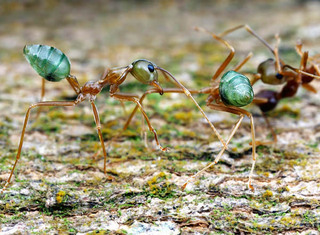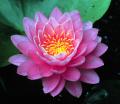Updated: 14 December, 2011
Overview
Ant Hunt! is a citizen science project first conceptualized in the fall of 2004. Its goals are
to teach discovery in schools, to study, monitor, and map species, and
to share high-quality data for understanding and managing nature.
In February, 2005, we presented Ant Hunt! at a meeting on
"How to study & monitor life on Earth,"
and it was well received.
The organizers of Ant Hunt! now include individuals at
the California Academy of Sciences, Conservation International, Discover
Life, Harvard University, Missouri Botanical Garden, National Biological
Information Infrastructure, and Smithsonian Institution.
In addition to our educational and scientific goals, we are particularly
interested in studying invasive ants to help manage their impact and spread.
We plan to launch a full-scale Ant Hunt! at multiple sites across the United States and
Canada on Ant Day, 10 June, 2006, in celebration of Ed "The Naturalist" Wilson's birthday.
In the meantime, we are developing and testing methods in schools and with community groups
at targeted sites around the U.S.
Timeline:
- August, 2004 - February, 2005 -- Build on-line identification guides to North American ants.
- October-December, 2004 -- Develop collecting & sorting methods with undergraduates at the University of Georgia, Athens.
- February, 2005 -- First test of a local identification guide with Ms. G's AP Biology Class, Cedar Shoals High School, Athens, Georgia.
- late April, 2005 -- Ant Hunt! at Desert Museum, Tucson.
- starting April, 2005, or when it gets a little warmer -- testing with schools associated with California Academy of Sciences and Missouri Botanical Garden.
- May, 2005 -- Roving Ant Hunt! from Athens, Georgia to Southern Appalachians, North Carolina, with Cedar Shoals High School and University of Georgia students.
- 10-11 June, 2005 -- Ant Hunt! in Central Park, New York.
- fall, 2005, before it gets too cold -- more testing at other schools and local parks -- email somebody@discoverlife.org to join us.
- 10 June, 2006 -- Start of full-scale multi-site Ant Hunt!. All welcome.
Motivations for Participants:
- Learn about biodiversity in your own backyard
- Help identify and track ants throughout the nation
- Discover and name new species
- Compete with other schools to win prizes
|
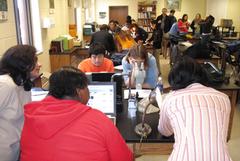
Cedar Shoals High School class works together to
identify ants and test an IDnature guide to their local species
Eligibility:
- Science classes grades 4(?) and up
- Local clubs, scout troops, etc.
- Others who are interested
Requirements:
- Dissecting microscope
- Computer, any browser, and either phone or high-speed connection to the Web
- Enthusiasm for discovery
|
|
How will Ant Hunt work?
|
Ant Hunt! participants will learn to collect, sort, identify, study, and map ants.
Through this Web page and some workshops, we will provide the training
teachers and group leaders need to conduct a successful Ant Hunt! in their
local community. Currently, we are testing methods for high school students.
Within a year we hope to have exercises that will be valuable to teaching
4th grade students and up.
Discover Life currently has identification guides and high-quality images to over
700 North American ant species that everyone can access through
http://www.discoverlife.org/nh/tx/Insecta/Hymenoptera/Formicidae.
Discover Life also has a Global Mapper and online reporting tools that
use maps and high-resolution aerial photographs served by Topozone.com.
Participants can use these to locate the exact positions where they find ants.
For example, try these to locate an exact point around the
Washington Monument,
steps of the National Museum of Natural History, or
Central Park, New York.
Simply click on the maps and photographs to zoom in.
Use the Global Mapper's "Find Place" option to locate points elsewhere.
- Organization of groups
- Community level
- School levels
- Funding
- Collecting
- Locate suitable collections sites
- Choosing sites
- Marking and numbering chosen sites
- Materials needed:
- Petri dishes or jar lids
- Bait
- Alcohol
- Methods:
|
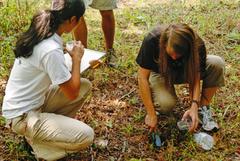
University of Georgia undergraduate sets a pitfall trap
|
- Sorting and Identifying
- Labeling:
Use acid-free paper, write on it with a pencil or India ink
Cut the label to be aproximately 1" by 1/2"
Write the trap number in the top left, county where found in top right
Put the year, month, and date along the bottom (ex. 20041210 for Dec. 10, 2004)
- Materials:
Use a microscope (correct microscope technique should be emphasized)
Fine tweezers
Many Petri dishes
70% alcohol is to be used in the dishes and vials to keep the ants moving freely,
but don't add so much to the dish that the ants float around
Vials for storing the ants, use the tweezers to transport ants from Petri dish to vial
- Method:
Once the ants are in the alcohol in the Petri dish under the microscope for sorting/observation,
it helps to sort by shuffling the ants that look similar from the main glob of ants into a smaller,
separate pile in a different spot in the dish.
|
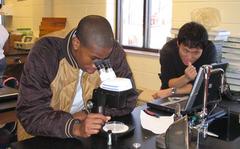
Cedar Shoals High School students use
microscope and computer guide to identify ants
|
- Reporting
- Quality Control
- Verifying identifications
- Mapping
- Competition Regulations
- Safety Concerns
|

Cedar Shoals High School student reports her group's findings
so that they can be compared with others
| |
|
Petri Dish Method
- Number the bottom of a petri dish and its corresponding vial for each collection site.
- Sprinkle small amounts of bait in each petri dish bottom and distribute to designated locations.
- Allow zzz time for ants to crawl into the dishes.
- To collect, place lid on petri dish and store closed petri dishes in freezer overnight.
- Use forceps to pick the (dead) ants out of each dish and place them into its corresponding vials.
|
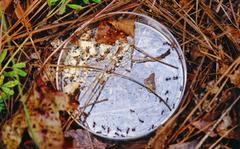
Petri Dish Trap
|
Pit-fall Method
- Number a vial for each collection site.
- Fill each vial a third of the way with rubbing alcohol.
- At each collection site, dig holes deep enough to place the uncapped vials all the way into the ground, so that the rim of each vial is at ground level.
- Come back zzz later to collect the vials.
|
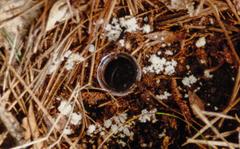
Pitfall Trap
|
Registration
E-mail somebody@discoverlife.org with a valid e-mail address and an IP address of a computer from which you will be working on the project. To find your IP address, click here.
Organizers
Under revision, pending response
Contacts
Email somebody@discoverlife.org at Discover Life, or call USA-706-542-6676,
for more information about Ant Hunt!
Acknowledgements
We thank Tatiana Barron, David De Leon, Philip Lennox, and Emily Susko for their contributions to the content of this page.
|
